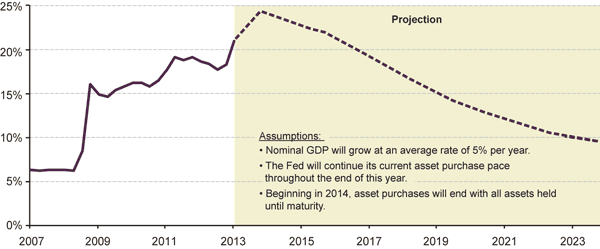by Scott Minerd, CIO, Guggenheim Partners LLC
“A number of macro trends have proven fortuitous for the Federal Reserve’s implementation of quantitative easing (QE). The European financial crisis and recession, as well as the depreciation of the yen, have driven global investors to dollar-denominated assets as a safe haven. The relatively strong dollar has kept input prices down, giving the Fed greater leeway to be extremely accommodative in tackling the unemployment problem without stoking inflation.
As evidenced in today’s congressional Joint Economic Committee hearing, the Fed is facing increasing scrutiny over potential exit strategies for its asset purchase program and has been making an effort to communicate clearly with the markets to avoid surprises. One of the more attractive options for the Fed appears to be to let its portfolio wind down over an extended period, instead of selling assets. If the Fed takes this route, it could increase bank reserve requirements to opportunistically restrict money growth, or engage in reverse repurchase agreements to drain liquidity out of the system as needed.”
Economic Data Releases
Mixed Data and Low Inflation Leave Room for Continued Quantitative Easing
- Industrial production fell by 0.5% in April, the most in five months.
- Housing starts dropped 16.5% in April to a five-month low of 853,000 at an annualized rate.
- Building permits jumped 14.3% in April to a annualized rate of 1.017 million, the most since June 2008.
- The NAHB homebuilder confidence index rose to 44 in May, the first improvement in five months.
- Initial jobless claims for the week ended May 11th rose to a six-week high of 360,000.
- The University of Michigan consumer confidence index jumped to 86.7 in May, the highest since July 2007.
- The leading indicator index had the best one-month gain in over a year in April, rising 0.6%.
- Regional Fed indices disappointed, with the Empire, Philadelphia, and Chicago indices all unexpectedly falling.
- CPI inflation fell to 1.1% in April, the lowest since 2010.
Eurozone Recession Reaches Record Length, Signs of Abenomics Impact in Japan
- GDP in the eurozone contracted for a record sixth straight quarter, falling 0.2% in the first quarter.
- German GDP rose a less-than-expected 0.1%, while France saw a second consecutive quarter of contraction, and Italian GDP shrank for a seventh quarter.
- The eurozone CPI fell 0.1% in April, putting the year-over-year CPI at 1.2%, a more than three-year low.
- Home prices in the U.K. increased 2.1% in May to a record high.
- U.K. consumer prices rose less than forecast in March, putting the CPI up 2.4% from a year earlier.
- Japan’s GDP grew at a better-than-expected 3.5% annualized rate in the first quarter.
- Japanese industrial production rose for a fourth straight month in March, the best streak since 2011.
Chart of the Week
Selling Not Required
If the Fed continues its current pace of asset purchases through the rest of 2013, the total amount of assets on its balance sheet will reach approximately 24% of GDP by the end of the year. When the Fed changes its monetary policy, it can do so by either selling its current assets or simply letting the bonds mature by holding them to maturity. If the Fed holds its bonds to maturity, its total assets to GDP ratio could fall to below 10% by 2023.

Source: Federal Reserve Bank of New York, Bloomberg, Guggenheim Investments. *Note: We assume the nominal GDP will grow at an average rate of 5% per year. We also assume the Fed will continue its current asset purchase pace throughout the end of this year but stop purchasing with no asset sales starting next year. Only maturing principals will be absorbed. Interest income will be retained for operating and money supply purposes.
This article is distributed for informational purposes only and should not be considered as investing advice or a recommendation of any particular security, strategy or investment product. This article contains opinions of the author but not necessarily those of Guggenheim Partners or its subsidiaries. The author’s opinions are subject to change without notice. Forward looking statements, estimates, and certain information contained herein are based upon proprietary and non-proprietary research and other sources. Information contained herein has been obtained from sources believed to be reliable, but are not assured as to accuracy. No part of this article may be reproduced in any form, or referred to in any other publication, without express written permission of Guggenheim Partners, LLC. ©2013, Guggenheim Partners. Past performance is not indicative of future results. There is neither representation nor warranty as to the current accuracy of, nor liability for, decisions based on such information.
Copyright © Guggenheim Partners LLC












